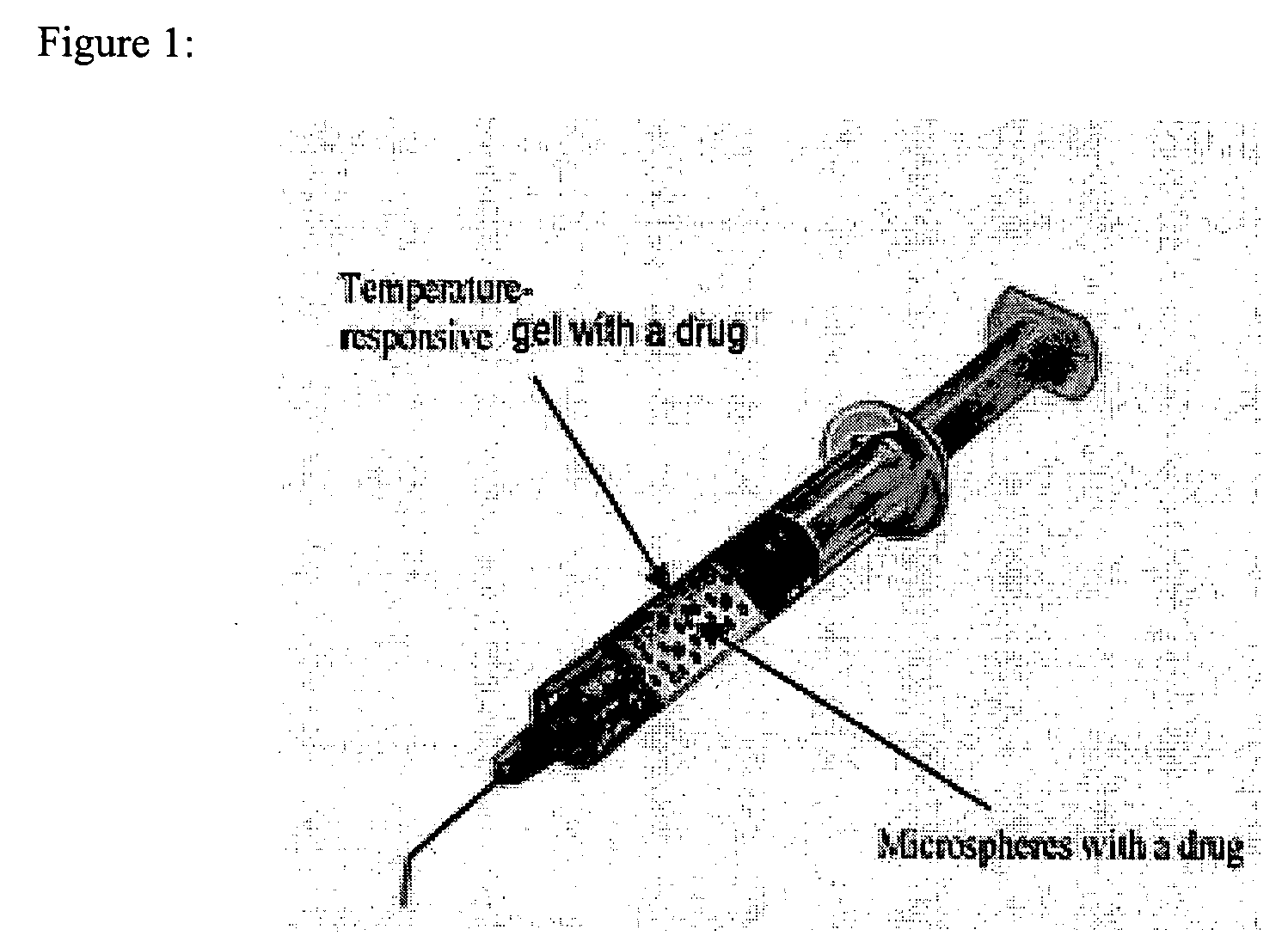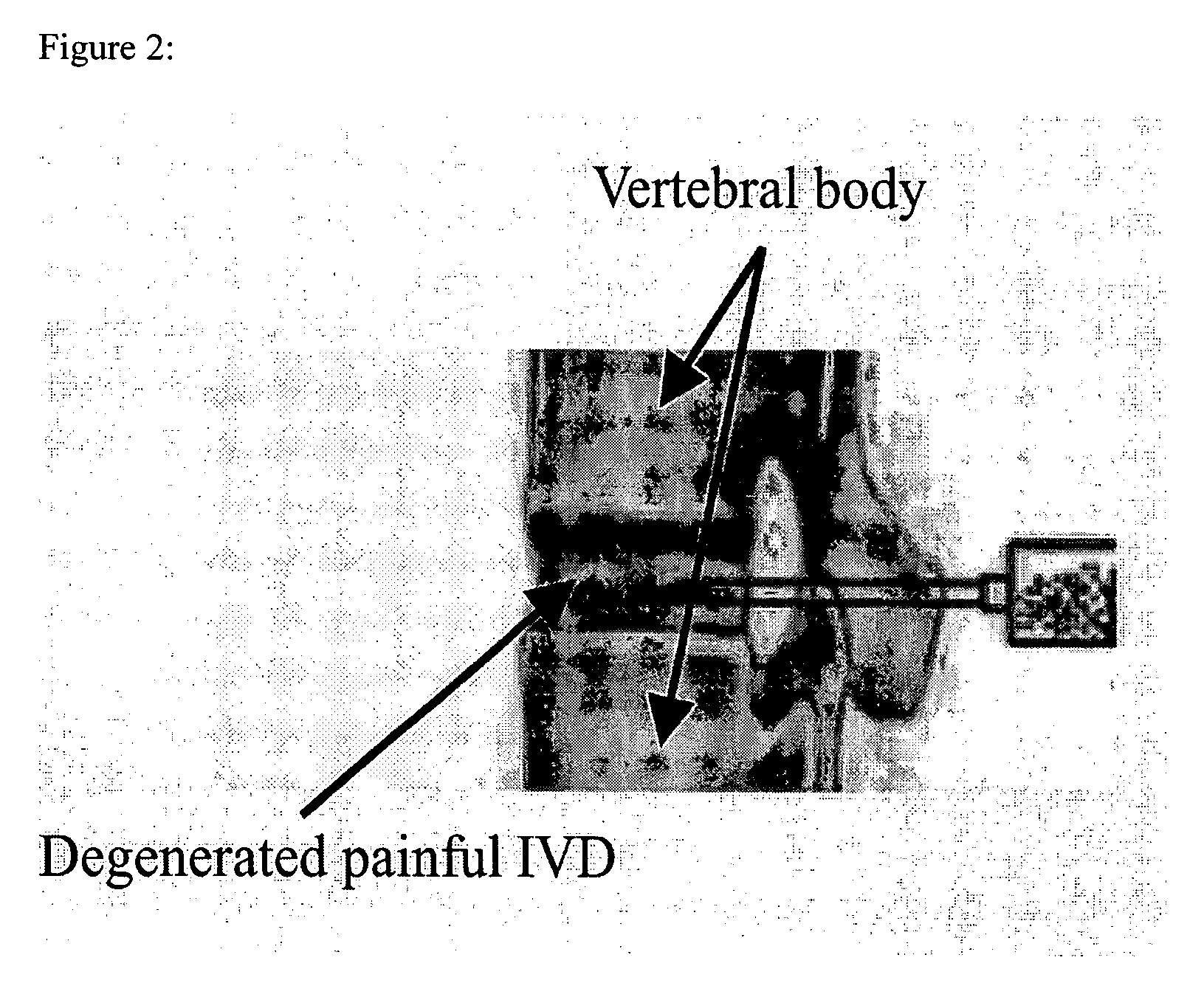In situ controlled release drug delivery system
a controlled release and drug delivery technology, applied in the direction of drug compositions, heterocyclic compound active ingredients, plant/algae/fungi/lichens ingredients, etc., can solve the problems of not allowing the desired effect to be achieved, the delivery system is largely systemic and rapid, and many drugs and therapeutic agents have relatively short half-lives, etc., to avoid surgical intervention, short or long-term effectiveness or treatment, and less frequent administration
- Summary
- Abstract
- Description
- Claims
- Application Information
AI Technical Summary
Benefits of technology
Problems solved by technology
Method used
Image
Examples
example 1
Preparation of Microspheres
[0075] Microsphere by solvent evaporation. Five % (w / v) of PCL (Mw: 65000 Da) and 1% (w / v) of drug were dissolved in methylene chloride (MC). Resultant solution was homogenized at about 3000 rpm for 2 min at room temperature. It was then poured and agitated at 500 rpm in 100 ml of 1% (w / v) polyvinyl alcohol (PVA) for 4 hrs at room temperature. After being hardened, the MSs will be collected by centrifugation (10 min at 4000 rpm), washed three times with 10 ml of ultra pure water, and lyophilized by a freezer. The mean diameter of the lyophilized MSs will be 20 μm within a standard deviation of ±10 μm. Microspheres by hot melt encapsulation: Five % (w / v) of PCL powders was melted in 10 ml of deionized water at 70 deg C., and the mixture was agitated thoroughly by vortex for 1 minute. It was then suspended in 200 ml of water solvent that was heated 5 deg C. above the melting point of the PCL and stirred with a four-blade impeller continuously at 1000 rpm fo...
example 2
Intradiscal Drug Delivery System for The Treatment of Discogenic Low Back Pain
Introduction:
[0077] Low back pain (LBP) ranks 2nd among common medical symptoms, 5th in causes of hospitalization, and 3rd in leading to surgical procedures in the USA. Degenerative disc disease (DDD) is generally considered as a major cause of LBP. Immunohistochemical studies showed LBP as microvascular blood vessels accompanied nerve fibers growing into the pain level disc and these are expressed as nerve growth factor[1]. LBP treatments include medication, steroid injection, physical therapy, surgery, etc. Most are temporal pain relief or destructive to the disc requiring post-surgical care with high complication rates, and often lead to instability of the motion segments. One of the solutions to the LBP would be an injectable carrier that provides a long-term pain relief without destroying the disc. The objective of this study is to develop a microsphere (MS)-dispersed in-situ forming hydrogel matri...
example 3
Development of Nucleoplasty by In-Situ Forming Hydrogels
Introduction
[0086] Nucleoplasty, the replacement of the nucleus pulposus (NP), is a viable option for surgical treatment of degenerative disc along with total disc replacement and intervertebral body fusion. In-situ forming nucleus prosthesis having mechanical, chemical, surface, and viscoelastic compatibility are being investigated. The objective of this study was to develop the in-situ forming nucleoplasty that addresses some of these issues.
Materials and Methods
[0087] Preparation of the in-situ forming hydrogel: The in-situ forming gels were first prepared by dissolving 15 to 20% (w / v) of poly(ethylene oxide-propylene oxide-ethylene oxide) (poly(EO-PO-EO)) and 0.2 to 1.0% (w / v) sodium hyaluronate(SH) in deionized water at an ambient temperature. Two % (w / v) of 1-ethyl-3-(3-dimethylaminopropyl)carbodiimide hydrochloride(CDI) as a cross-linker was added to the solution[1]. The pH was adjusted to 5.5 by 0.1N HCl. After st...
PUM
| Property | Measurement | Unit |
|---|---|---|
| volume change | aaaaa | aaaaa |
| volume change | aaaaa | aaaaa |
| phase angle | aaaaa | aaaaa |
Abstract
Description
Claims
Application Information
 Login to View More
Login to View More - R&D
- Intellectual Property
- Life Sciences
- Materials
- Tech Scout
- Unparalleled Data Quality
- Higher Quality Content
- 60% Fewer Hallucinations
Browse by: Latest US Patents, China's latest patents, Technical Efficacy Thesaurus, Application Domain, Technology Topic, Popular Technical Reports.
© 2025 PatSnap. All rights reserved.Legal|Privacy policy|Modern Slavery Act Transparency Statement|Sitemap|About US| Contact US: help@patsnap.com



